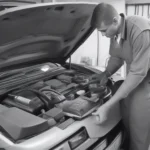Ever wondered how mechanics pinpoint problems in your car’s engine? Imagine a scenario: You’re driving down a busy street in New York City, and suddenly your car sputters and loses power. You pull over, heart pounding, and frantically try to figure out what’s wrong. In the past, mechanics would have to rely on their intuition and experience, but now, thanks to auto scanning tools, they can diagnose the issue quickly and accurately.
What is an Auto Scanning Tool?
An auto scanning tool, also known as a diagnostic scanner or code reader, is a device that connects to your car’s On-Board Diagnostic (OBD) port. It’s like a translator that can read the car’s internal language, allowing mechanics to understand what’s happening under the hood. These tools are essential for modern vehicle diagnostics, as they provide valuable insights into a car’s performance, identify potential problems, and help mechanics troubleshoot and repair issues efficiently.
The Importance of Auto Scanning Tools
From a Mechanic’s Perspective:
Think of it as a modern-day stethoscope, but for cars. It allows mechanics to listen to the car’s “heartbeat” and detect any irregularities. Imagine a scenario: A mechanic is trying to diagnose a misfire in a BMW 3 Series. Instead of relying on guesswork, they can use a diagnostic scanner to read the engine control unit (ECU) and identify the specific cylinder causing the issue. This saves time, money, and frustration for both the mechanic and the car owner.
From a Technical Perspective:
Auto scanning tools work by communicating with the vehicle’s control modules, such as the ECU, transmission control module (TCM), and airbag control module (ACM). They read diagnostic trouble codes (DTCs), which are basically error messages stored in the vehicle’s memory. These codes provide valuable information about potential problems in various systems, including the engine, transmission, brakes, and airbags.
From an Economic Perspective:
Auto scanning tools are an investment for any serious mechanic. They allow for quicker and more accurate diagnoses, leading to faster repairs and reduced downtime for customers. This translates to increased customer satisfaction and a more profitable business.
Common Questions About Auto Scanning Tools:
What types of auto scanning tools are available?
There are several types of auto scanning tools, ranging from basic code readers to sophisticated diagnostic scanners. Some common options include:
- OBD II Scanners: These are the most basic type, capable of reading and clearing DTCs for vehicles manufactured after 1996. They’re often inexpensive and user-friendly.
- Dealer-Level Scanners: These are more advanced tools used by dealerships and professional mechanics. They offer extensive diagnostic capabilities, including live data readings, ECU programming, and advanced fault analysis. For example, the “Dealer Scanner For European Cars” mentioned in the prompt would fall under this category.
- Handheld Scanners: These are portable and convenient, perfect for quick diagnostics on the go. They often offer Bluetooth connectivity and smartphone apps for easy data access.
Which auto scanning tool is right for me?
The best auto scanning tool for you depends on your needs and experience level. If you’re a DIY enthusiast, a basic OBD II scanner might suffice. However, if you’re a professional mechanic or work on European vehicles, a dealer-level scanner is essential.
How do I use an auto scanning tool?
Using an auto scanning tool is generally straightforward. Most tools come with instructions, and many even have user-friendly interfaces. You’ll typically need to connect the tool to the OBD port, which is usually located under the dashboard. Once connected, follow the prompts on the screen to perform diagnostics and view data.
Where can I buy an auto scanning tool?
Auto scanning tools are available from various online retailers, automotive parts stores, and even dealerships.
Are there any risks associated with using auto scanning tools?
While generally safe, there are some risks involved in using auto scanning tools.
- Incorrectly interpreting DTCs could lead to unnecessary repairs.
- Modifying ECU settings without proper knowledge can damage the vehicle.
- Using a counterfeit tool could lead to inaccurate results.
How do I choose the right auto scanning tool?
Here are some tips for selecting an auto scanning tool:
- Compatibility: Ensure the tool is compatible with your vehicle’s year, make, and model.
- Features: Choose a tool with the features you need, such as live data readings, ECU programming, and advanced diagnostics.
- Brand Reputation: Consider brands known for quality and reliability.
Can I learn more about specific auto scanning tools?
Yes! Websites like Diag XCar and forums like the “Car Mechanic Forum” (a hypothetical forum) are great resources for researching different models, reviews, and user experiences.
The Future of Auto Scanning Tools
As technology advances, auto scanning tools are becoming even more sophisticated. The integration of artificial intelligence (AI) is paving the way for predictive diagnostics, where the tool can anticipate potential problems before they occur. Imagine a world where your car’s AI system notifies you about a potential brake pad failure weeks before it happens. This proactive approach could dramatically improve vehicle safety and reduce maintenance costs.
Conclusion
Auto scanning tools have revolutionized the way mechanics diagnose and repair vehicles. They’ve made the process faster, more accurate, and more efficient. As technology continues to evolve, we can expect even more innovative tools to emerge, making vehicle maintenance even easier and more cost-effective.
Need help with your auto scanning tool? Our experts at Diag XCar are here to assist you with installation and troubleshooting! Reach out to us at +84767531508 via WhatsApp for 24/7 support.
Do you have any questions about auto scanning tools? Share your thoughts in the comments below! We’d love to hear from you.



